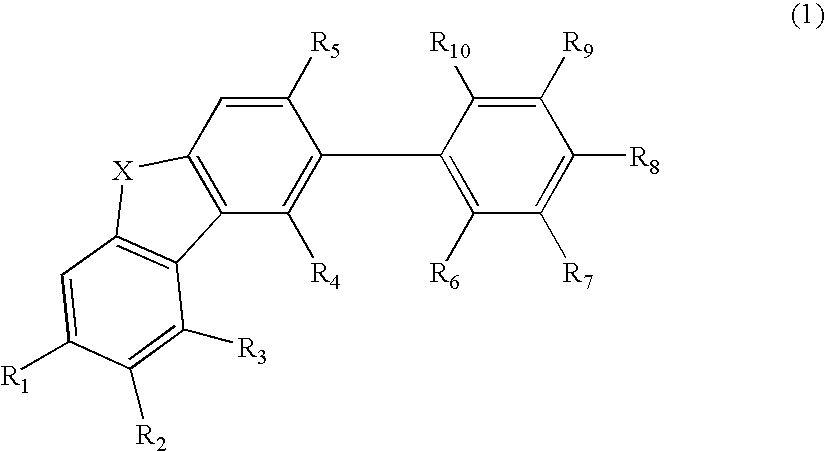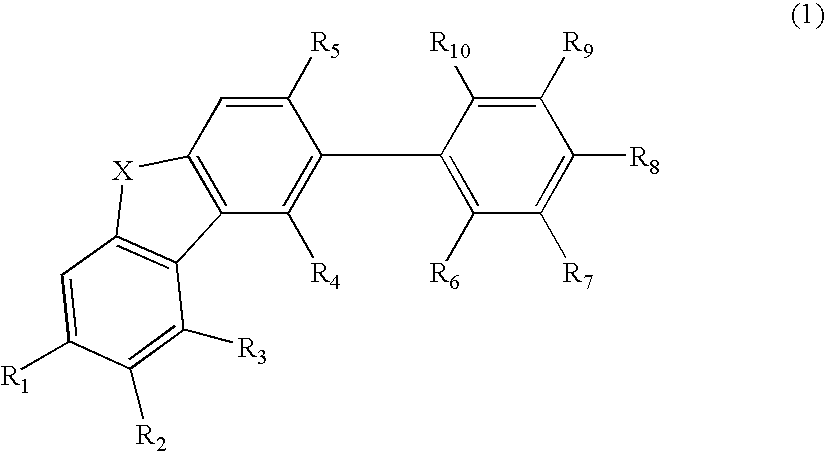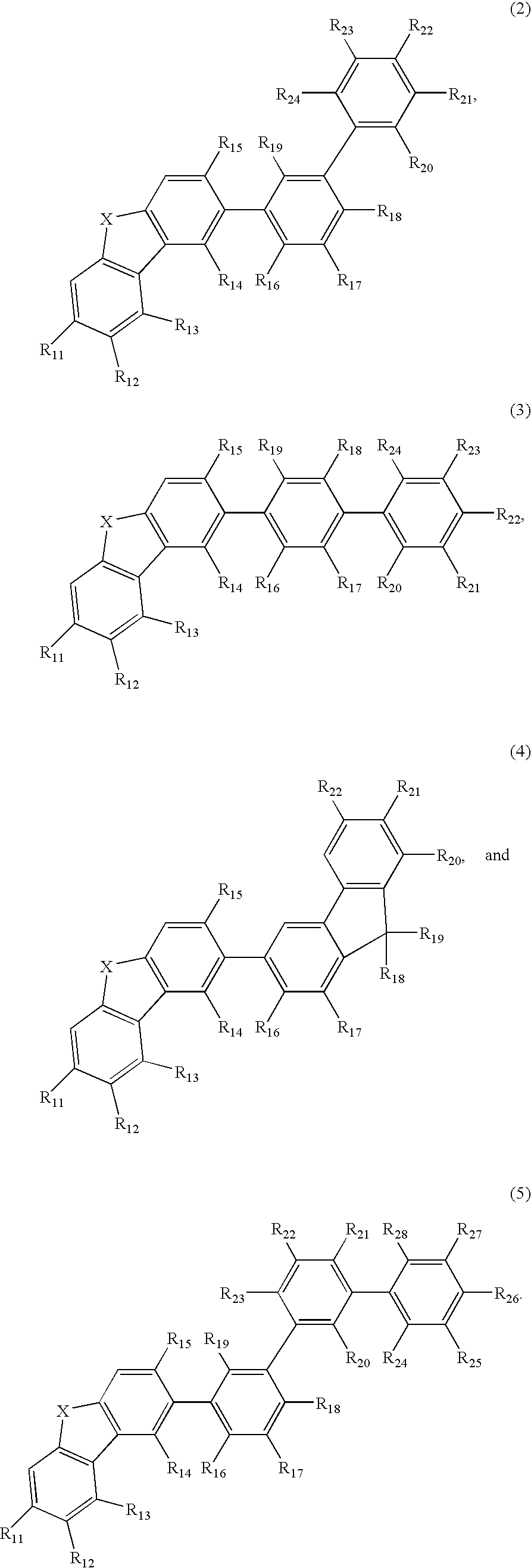Material for organic electroluminescent element and organic electroluminescent element employing the same
a technology of electroluminescent elements and materials, applied in the direction of discharge tube/lamp details, discharge tube luminescnet screens, organic chemistry, etc., can solve the problems of small energy level of excited triplet states of proposed compounds, adversely affecting emitting efficiency and lifetime, and no device performance advantage. , to achieve the effect of high efficiency and high heat resistan
- Summary
- Abstract
- Description
- Claims
- Application Information
AI Technical Summary
Benefits of technology
Problems solved by technology
Method used
Image
Examples
synthesis example 1
Synthesis of Compound No. 6
[0118]
[0119]A three-necked flask was charged with 3.4 g (1.2 eq., 12 mmol) of compound 1, 3.2 g (1 eq., 10 mmol) of compound 2, 10 ml of 2M Na2CO3 aqueos solution (20 mmol), 50 ml of DME, and 0.58 g of 5 mol % Pd[PPh3]4 (0.5 mmol). The contents were refluxed for 8 hrs in an argon atmosphere.
[0120]After the reaction, the reaction product mixture was cooled to room temperature and poured into a separatory funnel. After adding 50 ml of water, the reaction product mixture was extracted with CH2Cl2. The extract was dried over MgSO4, filtrated and condensed. The condensate was dissolved in 300 ml toluene and purified by a column chromatography. The purified product was condensed, evaporated to dryness and washed with ethyl acetate (30 ml) three times, to obtain a white powder (No. 6) which was then purified by sublimation to obtain 3.5 g of white solid.
FD Mass Spectroscopy Analysis
[0121]C36H23NO: calculated 485, found 485
synthesis example 2
Synthesis of Compound No. 1
[0122]
[0123]A three-necked flask was charged with 7.1 g (1 eq., 15 mmol) of compound 3, 3.8 g (1.2 eq., 18 mmol) of compound 4, 15 ml of 2M Na2CO3 aqueous solution (30 mmol), 50 ml of THF, and 0.87 g of 5 mol % Pd[PPh3]4 (0.75 mmol). The contents were refluxed for 8 hrs in an argon atmosphere.
[0124]After the reaction, the reaction product mixture was cooled to room temperature and poured into 100 ml of methanol. The precipitated solid was filtrated with suction and purified by a column chromatography. The purified product was condensed, evaporated to dryness and recrystallized twice, to obtain a white powder (No. 1) which was then purified by sublimation to obtain 2.6 g of white solid.
[0125]FD Mass Spectroscopy Analysis
[0126]C42H27NO: calculated 561, found 561
synthesis example 3
Synthesis of Compound No. 12
[0127]
[0128]A three-necked flask was charged with 3.4 g (1.2 eq., 16 mmol) of compound 4, 6.5 g (1 eq., 13 mmol) of compound 5, 13 ml of 2M Na2CO3 aqueous solution (26 mmol), 40 ml of DME, and 0.75 g of 5 mol % Pd[PPh3]4 (0.65 mmol). The contents were refluxed for 8 hrs in an argon atmosphere.
[0129]After the reaction, the reaction product mixture was cooled to room temperature and poured into a separatory funnel. After adding 50 ml of water, the reaction product mixture was extracted with CH2Cl2. The extract was purified by a column chromatography. The purified product was condensed, evaporated to dryness and recrystallized twice, to obtain a white powder (No. 12) which was then purified by sublimation to obtain 3.2 g of white solid.
[0130]FD Mass Spectroscopy Analysis
[0131]C42H25NO2: calculated 575, found 575
PUM
| Property | Measurement | Unit |
|---|---|---|
| maximum peak wavelength | aaaaa | aaaaa |
| carbon number | aaaaa | aaaaa |
| carbon number | aaaaa | aaaaa |
Abstract
Description
Claims
Application Information
 Login to View More
Login to View More - R&D
- Intellectual Property
- Life Sciences
- Materials
- Tech Scout
- Unparalleled Data Quality
- Higher Quality Content
- 60% Fewer Hallucinations
Browse by: Latest US Patents, China's latest patents, Technical Efficacy Thesaurus, Application Domain, Technology Topic, Popular Technical Reports.
© 2025 PatSnap. All rights reserved.Legal|Privacy policy|Modern Slavery Act Transparency Statement|Sitemap|About US| Contact US: help@patsnap.com



